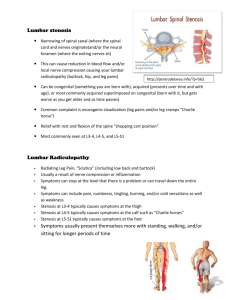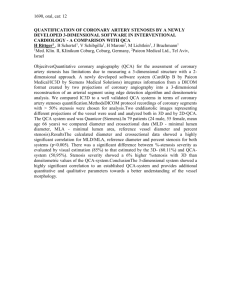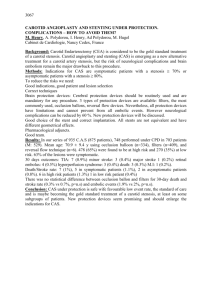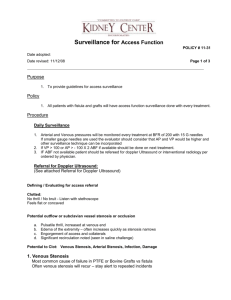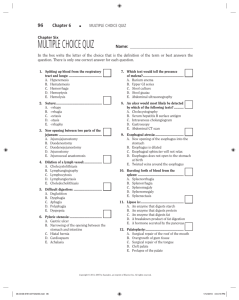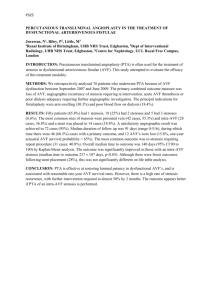Non-Newtonian Arterial Blood Flow through an Overlapping Stenosis
advertisement
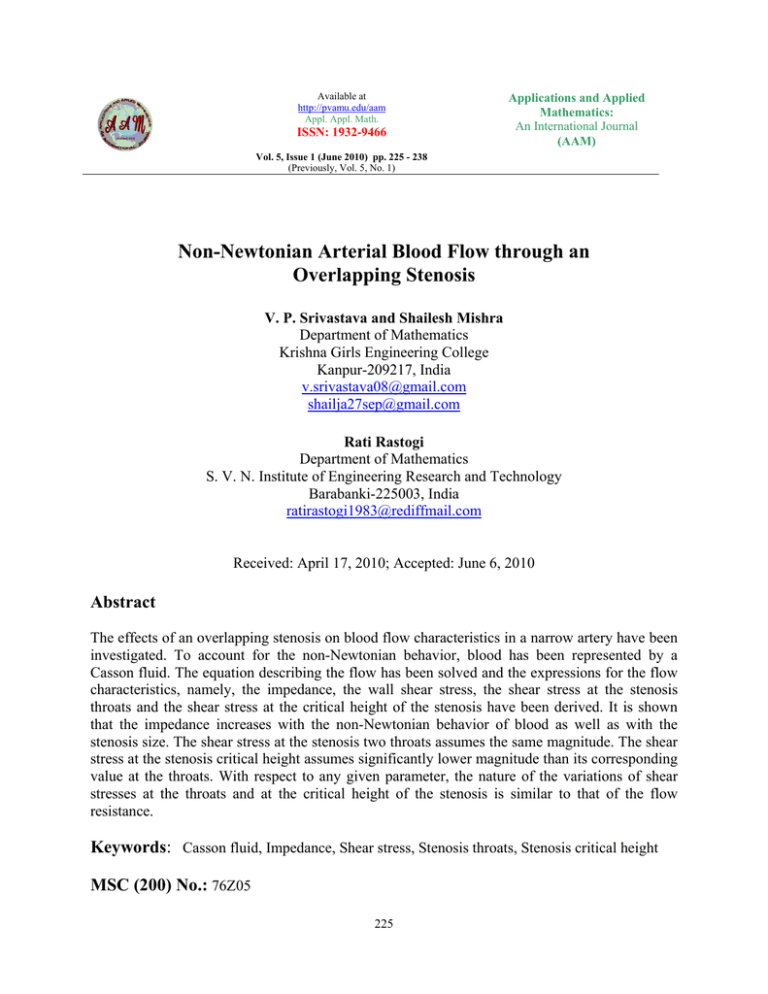
Available at http://pvamu.edu/aam Appl. Appl. Math. ISSN: 1932-9466 Applications and Applied Mathematics: An International Journal (AAM) Vol. 5, Issue 1 (June 2010) pp. 225 - 238 (Previously, Vol. 5, No. 1) Non-Newtonian Arterial Blood Flow through an Overlapping Stenosis V. P. Srivastava and Shailesh Mishra Department of Mathematics Krishna Girls Engineering College Kanpur-209217, India v.srivastava08@gmail.com shailja27sep@gmail.com Rati Rastogi Department of Mathematics S. V. N. Institute of Engineering Research and Technology Barabanki-225003, India ratirastogi1983@rediffmail.com Received: April 17, 2010; Accepted: June 6, 2010 Abstract The effects of an overlapping stenosis on blood flow characteristics in a narrow artery have been investigated. To account for the non-Newtonian behavior, blood has been represented by a Casson fluid. The equation describing the flow has been solved and the expressions for the flow characteristics, namely, the impedance, the wall shear stress, the shear stress at the stenosis throats and the shear stress at the critical height of the stenosis have been derived. It is shown that the impedance increases with the non-Newtonian behavior of blood as well as with the stenosis size. The shear stress at the stenosis two throats assumes the same magnitude. The shear stress at the stenosis critical height assumes significantly lower magnitude than its corresponding value at the throats. With respect to any given parameter, the nature of the variations of shear stresses at the throats and at the critical height of the stenosis is similar to that of the flow resistance. Keywords: Casson fluid, Impedance, Shear stress, Stenosis throats, Stenosis critical height MSC (200) No.: 76Z05 225 226 1. Srivastava et al. Introduction The frequently occurring cardiovascular disease, stenosis or arteriosclerosis is the abnormal and unnatural growth in the arterial wall thickness that develops at various locations of the cardiovascular system under diseased conditions which occasionally results into serious consequences Srivastava (1996). Stenosis is a medical term which means narrowing of anybody passage, tube or orifice Young (1979). Although, the root causes to the formation of stenotic lesions are not well understood but it is established that the fluid dynamical parameters, particularly, the high wall shear stress play an important role in the genesis of the disease. Regardless of the cause, it is known that once an obstruction has developed, it results into significant changes in blood flow, pressure distribution, wall shear stress and the impedance (flow resistance). In the region of narrowing arterial constriction, the flow accelerates and consequently the velocity gradient near the wall region is steeper due to the increased core velocity resulting in relatively large shear stress on the wall even for a mild stenosis. The possibility that the haemodynamic factors play an important role in the genesis and proliferation of stenosis has attracted the interest of researchers to study blood flow through local constrictions Young (1968); Young and Tsai (1973); Deshpande et al. (1976), Caro et al. (1978); Ahmed and Giddens (1983); Ku (1997) and others during the past few decades. An account of the most of the theoretical and experimental studies, reported so far, may be had from Young (1979), Srivastava (1996, 2002), Sarkar and Jayaraman (1998), Mishra and Verma (2007), Mekheimer and Kot (2008), Srivastava and Rastogi (2009, 2010), etc. The studies conducted in the literature are mainly concerned with the single symmetric and nonsymmetric stenoses. However, the constrictions may develop in series (multiple stenoses) or may be of irregular shapes or overlapping. Chakravarty and Mandal (1994) studied the effects of an overlapping stenosis on arterial flow problem analytically assuming the pressure variation only along the axis of the tube. Layek et al. (2009) investigated the effects of an overlapping stenosis on flow characteristics considering the pressure variation in both the radial and axial directions of the arterial segment under consideration and most recently Srivastava et al. (2010) addressed the problem of blood flow through an overlapping stenosis assuming that the flowing blood is represented by a two-layered macroscopic two-phase model Srivastava (2007). It is well accepted that blood behaves like a non-Newtonian fluid under certain flow conditions, particularly, at low shear rates Merrill et al. (1965). An examination of viscometric data Bugliearello et al. (1965); Chein et al. (1965); Rand et al. (1964) suggests that non-Newtonian behavior of blood increases rapidly, when hematocrit rises above 20%, possibly reaching a maximum at between 40-70%. Merrill et al. (1965) established that the Casson model holds satisfactory in small vessels (of diameter 130-1000 m) within certain wall shear stress limits. An attempt is made in the present investigation to explore the effects of an overlapping stenosis on the flow characteristics of blood taking into account that the flowing blood is to be treated as an incompressible non-Newtonian (Casson) fluid. The arterial wall segment is considered to be rigid as well as deformable. The wall in the vicinity of the stenosis is usually relatively rigid AAM: Intern. J., Vol. 5, Issue 1 (June 2010) [Previously, Vol. 5, No. 1] 227 when stenosis develops in human vasculature. The artery length is considered to be large enough as compared to its radius so that the entrance, end and special wall effects can be neglected. 2. Formulation of the Problem Consider the axisymmetric flow of blood through a circular cylindrical tube with an overlapping constriction specified at the position as shown in Figure 1. The geometry of the stenosis which is assumed to be manifested in the arterial segment is described Chakravarty and Mandal (1994); Layek et al. (2009); Srivastava et al. (2010) as R( z ) 3 1 11( z d ) L30 47( z d ) 2 L20 72( z d ) 3 L0 36( z d ) 4 , d z d L0 , 4 R0 2 R0 L0 =1, otherwise, (1) where R (z) and R0 are the radius of the tube with and without stenosis, respectively, Rp is the radius of the plug flow region, L0 is the length of the stenosis and d indicates its location, is the maximum projection (maximum height) of the stenosis into the lumen, appears at two locations: z =d+L0/6 and z = d+5L0/6. The stenosis height at z = d+L0/2 from origin, called critical height, is 3 /4. Figure 1. The flow geometry of an arterial overlapping stenosis Blood is assumed to be represented by a Casson fluid and following the report of Young (1968) and considering the axisymmetric, laminar, steady, one-dimensional flow of blood in an artery, the general constitutive equation in a mild stenosis case, under the conditions Young (1968); Srivastava and Rastogi (2009), /R0<<1, Re (2 /L0) <<1 and 2R0/L0~O (1), may be written as 228 Srivastava et al. dp 1 r 0, dz r r (2) where (r, z) are the cylindrical polar coordinates with z measured along the tube axis and r measured normal to the axis of the tube, Re is the tube Reynolds number, is the shear stress and p is the pressure. The boundary conditions are u = 0 on r = R (z), (3) u 0 on r = 0, r (4) where u is the velocity of the fluid. For a Casson fluid, the stress-strain relationship is given by 1/ 2 u p r 1/ 2 0 0, 1/ 2 u r 1/ 2 , 0, (5) 0, (6) where up is the constant plug flow velocity, is the fluid viscosity and 0 is the yield stress. 3. Analysis The expression for the velocity, u obtained as the solution of equation (2) subject to the boundary conditions (3) and (4), is obtained as 2 2 R02 dp R r 0 R0 u 4 dz R0 R0 R R0 1/ 2 1 dp 4 R03/ 2 0 3 2 dz r R0 R 3/ 2 r 3/ 2 , R p r R ( z ). R0 R0 The constant plug flow velocity, up may be obtained from equation (7) evaluated at r =Rp. (7) AAM: Intern. J., Vol. 5, Issue 1 (June 2010) [Previously, Vol. 5, No. 1] 229 The flow flux, Q when Rp<< R (i.e., the radius of the plug flow region is very small as compared to the non-plug flow region), is calculated as 1/ 2 R 4 dp R 0 R 4 7 / 2 0 1 dp R R0 , Q 0 dz 8 dz R0 3 R0 7 2 R0 4 3 7 (8) for 0 ( R 0 / 2)( R / R0 )(dp / dz ), dp 8Q 4 ( z) , dz R0 (9) with n1/ 2 1 64 n 16 ( z) , ( R / R0 ) 4 49 ( R / R0 ) 7 ( R / R0 ) 5 / 2 R03 0 , a non-dimensional Casson fluid parameter. and n 4Q The pressure drop, p (= p at z = 0 and – p at z = L) across the stenosis in the tube of length, L is calculated from equation (9) as L p ( 0 8Q dp ) dz , dz R04 (10) where L d ( z )dz ( z ) 0 0 R / R 1 o dz d L0 L d d L0 ( z)dz ( z )R / R 1 dz . o The first and third integrals in the expression for obtained above are straight forward whereas evaluation of the second integral is a formidable task and therefore will be evaluated numerically. 230 Srivastava et al. The expressions for the flow resistance, λ , the wall shear stress distribution in the stenotic region, τ R , the shear stresses at stenosis throats, τ s and at the critical height of the stenosis, τ c are given by p , Q R (11) R dp , 2 dz (12) R dp s , 2 dz R / R 15 / 4 R (13) R dp . 2 dz R / R0 13 /4 R0 (14) 0 0 c Following now the reports of Srivastava (1996) and Srivastava and Rastogi (2010), one obtains the final expressions for impedance (flow resistance), λ , the wall shear stress distribution in the stenotic region, τ R , the shear stresses at stenosis throats, τ s and at the stenosis critical height, τ c in their non-dimensional form as d L0 n1 / 2 1 64 n 16 dz , (15) 4 49 ( R / R0 ) 7 ( R / R0 ) 5 / 2 ( R / R0 ) 1 64 16 n1 / 2 n , R 7 ( R / R0 ) 3 / 2 ( R / R0 ) 3 49 (16) L 64 16 1 (1 0 ) 1 n n1 / 2 L 49 7 L d n 16 1 64 s + , n 7 (1 1.25 / R0 ) 3 / 2 (1 1.25 / R0 ) 3 49 1/ 2 c n1 / 2 16 1 64 + , n 7 (1 0.75 / R0 ) 3 / 2 (1 0.75 / R0 ) 3 49 (17) (18) where / 0 , (τ R , τ s , τ c ) ( τ R , τ s , τ c )/ 0 , 0 8 L / R04 and 0 4 Q / R03 are the flow resistance and shear stress respectively for a Newtonian fluid in the normal artery (no stenosis). It is worth to mention that shear stress at the stenosis two throats assume the same value. When n 0 , the corresponding results for a Newtonian fluid are derived from equations (15) - (18) as AAM: Intern. J., Vol. 5, Issue 1 (June 2010) [Previously, Vol. 5, No. 1] L 1 N 1 0 L L d L0 d dz , ( R / R0 ) 4 231 (19) RN 1 , ( R / R0 ) 3 (20) sN 1 , (1 1.25 / R0 ) 3 (21) cN 1 . (1 0.75 / R0 )3 (22) The subscript N stands for a Newtonian fluid. 4. Numerical Results and Discussion To discuss the results of the study quantitatively, computer codes are now developed to evaluate the analytical results obtained above (equations (15)-(18)) numerically. The parameter values Young(1968); Merrill et al (1965); Srivastava and Rastogi (2009) are selected as L0 (cm)= 1, L(cm) = 1 , 2 , 5 ; n 0 , 0.02 , 0.04 , 0.06 , 0.08 , 0.10 ; / R0 = 0 , 0.05 , 0.10 , 0.15 , 0.20. The present study corresponds to the flow of a Newtonian fluid and to the flow in a normal artery for parameter values n 0 and / R0 = 0, respectively. The impedance (resistance to flow), increases with n (non-Newtonian behavior of blood) and also with the stenosis height, / R0 (Figure 2). The blood flow characteristics, decreases with the increasing artery length, L which in turn implies that increases with stenosis length, L0. It is to note here that the difference in the magnitude of between a Newtonian fluid and a Casson fluid increases with the stenosis height, / R0 (Figure 3). For a given stenosis height, / R0 , the impedance, increases with small increasing values of n ( 0.05) and approaches to an asymptotic magnitude for higher values of n (Figure 4). 232 Srivastava et al. 4.0 L0=L=1 Numbers n 3.5 .10 .08 .06 .04 3.0 .02 2.5 0 2.0 1.5 1.0 0.00 0.05 /R0 0.10 0.15 0.20 Figure 2. Variation of impedance, with /R0for different n. 3.0 L0=1 Numbers (L, n) 2.5 ) .04 (1, 2.0 ) (1,0 (5,.04) 04) (2,. 1.5 ) (2,0 (5,0) 1.0 0.00 0.05 /R0 0.10 0.15 0.20 Figure 3. Variation of impedance, with /R0for different n. and L. AAM: Intern. J., Vol. 5, Issue 1 (June 2010) [Previously, Vol. 5, No. 1] 233 4.0 .20 3.5 L=L=1 Numbers /R0 .15 3.0 .10 2.5 .05 2.0 0 1.5 1.0 0.00 0.02 0.04 n 0.06 0.08 0.10 Figure 4. Variation of impedance, with n. for different /R0. The wall shear stress at any axial location in the stenotic region assumes higher magnitude for higher values of the Casson fluid parameter, n for any given stenosis height, / R0 . Also, the blood flow characteristics, R assumes higher magnitude for higher values of the stenosis height, / R0 for any given value of the Casson fluid parameter, n (Figure 5). R rapidly increases 2.0 Numbers (n, /R0) 1.8 1.6 (.04,.15) (.02.15) R (0,.15) (.04,.1) 1.4 (.02,.1) (0,.1) 1.2 1.0 0.0 0.1 0.2 0.3 0.4 0.5 z/L0 0.6 0.7 0.8 0.9 Figure 5. Wall shear stress distribution in the stenotic region for different n and /R. 1.0 234 Srivastava et al. from its approached value at z = 0 to its peak value in the upstream of the stenosis first throat at z/L0 = 1/6, it then decreases steeply in the downstream of the first throat to its magnitude at the critical height of stenosis at z/L0 = 1/2. R further increase steeply in the upstream of the second throat at z = 5/6 from its value at the critical height of stenosis to the same peak value as the first throat (at z/L0 = 1/6) and then decreases rapidly in the downstream of the second throat and attains its approached value (i.e., at z = 0) at the end point of the constriction profile at z/L0 = 1. The shear stress at the stenosis throats, s increases with increasing non-Newtonian behavior of blood for any given stenosis size (height and length). The nature of the variations in s with respect to any parameter is similar to that of the flow resistance, (Figures 2 and 6). However, the magnitude of the shear stress at stenosis throats, s is higher than the corresponding magnitude of the flow resistance, 3.0 .10 2.8 2.6 .08 .06 L0=L=1 Numbers n .04 .02 2.4 2.2 0 2.0 s 1.8 1.6 1.4 1.2 1.0 0.00 0.05 /R0 0.10 0.15 0.20 Figure 6. Variation of shear stress at stenosis throats,swith /R0 for different n. AAM: Intern. J., Vol. 5, Issue 1 (June 2010) [Previously, Vol. 5, No. 1] 235 3.5 .20 L0=L=1 Numbers /R0 3.0 .15 2.5 .10 s .05 2.0 0 1.5 1.0 0.00 0.02 0.04 n 0.06 0.08 0.10 Figure 7. Variation of shear stress at stenosis throats, s with n for different /R0. 2.4 2.2 .10 .08 L0=L=1 Numbers n .06 .04 2.0 .02 1.8 c 1.6 0 1.4 1.2 1.0 0.00 0.05 /R0 0.10 0.15 0.20 Figure 8. Variation of shear stress at critical height of the stenosis, c with /R0 for different n. 236 Srivastava et al. 2.8 .20 2.4 Numbers /R0 .15 .10 2.0 .05 c 0 1.6 1.2 0.00 0.02 0.04 n 0.06 0.08 0.10 Figure 9. Variations of shear stress at critical height of stenosis, c with n for different /R. (Figure 7). The variations in the magnitude of the shear stress at the critical height (at z/L0 = 0.5) of the stenosis, c is similar to that of the blood flow characteristics, and s . The flow characteristics, c assumes significantly lower magnitude than the corresponding values of both the blood flow characteristics, and s (Figures 8 and 9). 5. Conclusion A non-Newtonian fluid (Casson) model has been applied to investigate the effects on blood flow characteristics due to presence of an overlapping stenosis in arteries. The flow characteristics (impedance, wall shear stress in stenotic region, shear stress at stenosis throats and at the critical height of the stenosis) increase with non-Newtonian behavior of blood as well as stenosis size (height and length). The shear stress at stenosis two throats assumes the same magnitude. The shear stress at the stenosis critical height assumes significantly lower value than its corresponding magnitude at the throats. The nature of variations in the flow characteristics is similar with respect to any parameter. The significance of the study is now well understood from the discussion presented above. The Casson fluid seems to be more sensitive to stenosis than Newtonian fluid. The condition: / R0 << 1, limits the usefulness of the present analysis to very early stages of the vessel constriction, which allows the use of fully developed flow equations and leads to locally Poiseuille - like flow and closed form solutions. Use of / R0 parameter is restricted to values up to 0.15 (i.e., 28% stenosis by area reduction) as beyond this value a separation in the flow may occur even at a relatively small Reynolds number Young (1968); AAM: Intern. J., Vol. 5, Issue 1 (June 2010) [Previously, Vol. 5, No. 1] 237 Srivastava (1996); Srivastava and Rastogi (2009). The study has been conducted under certain simplifications and limitations, the consideration of a pulsatile flow and the cases of the severe stenosis thus remain the future scope of the study. Further careful investigations are therefore suggested to address the problem close the realistic situations. REFERENCES Ahmed, A. S. and Giddens, D. P. (1983). Velocity measurements in steady flow through axisymmetric stenosis at moderate Reynolds number, Journal of Biomechanics, Vol. 16, pp. 505-516. Bugliarello, G., Kapur, C. and Hsiao, G. (1965). The profile viscosity and other characteristics of blood flow in non-uniform shear field. Symp, of Biorheol. (Ed. Copley, A. L.), pp. 351-370, Intersci., New York. Caro, G.C. Pedley, T. J., Schroter, R.C. and Seed, W. A. (1978). The Mechanics of the Circulation. Oxford Medical, New York. Chakravarty, S. and Mandal, P. K. (1994). Mathematical modelling of blood flow through an overlapping stenosis. Math. Comput. Model., Vol. 19, pp. 59-73. Chein, S., Usmani, S., Taylor, H. M., Lundberg, J. L. and Gregerson, M. T. (1965). Effects of hematocrit and plasma proteins on human blood rheology at low shear rates. J. Appl. Physiol., Vol. 21, pp. 81-87. Deshpande, M. D. Giddens, D. P. and Mabon R. F. (1976). Steady laminar flow through modeled vascular stenosis. Journal of Biomechanics, Vol. 9, pp. 165-174. Ku, D. N. (1997). Blood flow in arteries, Ann. Rev. Fluid Mech., Vol. 29, pp. 399-434. Layek, G. C., Mukhopadhyay, S. and Gorla, R. S. D. (2009). Unsteady viscous flow with variable viscosity in a vascular tube with an overlapping constriction. Int. J. Engng. Sci. 47, pp. 649-659. Mekheimer, Kh. S. and Kot, M. A. E. (2008). Magnetic field and hall currents influences on blood flow through a stenotic artery, Applied Mathematics and Mechanics, Vol. 29, pp. 112. Merrill. F. W., Benis, A. M. Gilliland, E. R. Sherwood, T. K. and Salzman, E. W. (1965). Pressure-flow relations of human blood in hollow fibers at low shear rates. J. Appl. Physiol., Vol. 20, pp. 954-967. Mishra, B. K. and Verma, N. (2007). Effects of porous parameter and stenosis on the wall shear stress for the flow of blood in human body. Res. J. medicine and Medical Sciences, Vol.2, pp. 98-101. Rand, P. W., Lacombe, E., Hunt, H. E. and Austin, W. H. (1964). Viscosity of normal blood under normothermic and hypothermic conditions. J. Appl. Physiol., Vol.19, pp. 117-112. Sarkar, A. and Jayaraman, G. (1998). Correction to flow rate-pressure drop in coronary angioplasty; steady streaming effect, Journal of Biomechanics, Vol. 31, pp. 781-791. Srivastava, V. P. and Rastogi, R. (2009). Effects of hematocrit on impedance and shear stress during stenosed artery catheterization, Applications and Applied Mathematics, Vol. 4, pp. 98-113. 238 Srivastava et al. Srivastava, V. P. and Rastogi, R. (2010). Blood flow through stenosed catheterized artery: effects of hematocrit and stenosis shape. Comput. Math. Applc. 59, 1377-1785. Srivastava, V. P. (2002). Particulate suspension blood flow through stenotic arteries: effects of hematocrit and stenosis shape. Indian Journal of Pure and Applied Mathematics, Vol. 33, pp.1353-1360. Srivastava, V. P. (1996). Two-phase model of blood flow through stenosed tubes in the presence of a peripheral layer: applications, Journal of Biomechanics, Vol. 29, pp. 1377-1382. Srivastava, V. P., Rastogi, Rati and Vishnoi, Rochana. (2010). A two-layered suspension blood flow through an overlapping stenosis. Comput. and Math. with Applc., In press. Young, D. F. and Tsai F. Y. (1973). Flow characteristics in model of arterial stenosis-steady flow. Journal of Biomechanics, Vol. 6, pp. 395-410. Young, D. F. (1968). Effects of a time-dependent stenosis of flow through a tube, Journal of Eng. Ind., Vol. 90, pp. 248-254. Young, D. F. (1979). Fluid mechanics of arterial stenosis, Journal of Biomechanics, Vol. 101, pp.157-175.

